
Lodi is a city and comune in Lombardy, northern Italy, primarily on the western bank of the River Adda. It is the capital of the province of Lodi.

Assisi is a town and comune of Italy in the Province of Perugia in the Umbria region, on the western flank of Monte Subasio.

Pistoia (, Italian: [pisˈtoːja] is a city and comune in the Italian region of Tuscany, the capital of a province of the same name, located about 30 kilometres west and north of Florence and is crossed by the Ombrone Pistoiese, a tributary of the River Arno. It is a typical Italian medieval city, and it attracts many tourists, especially in the summer. The city is famous throughout Europe for its plant nurseries.

Spello is an ancient town and comune (township) of Italy, in the province of Perugia in east central Umbria, on the lower southern flank of Mt. Subasio. It is 6 km (4 mi) NNW of Foligno and 10 km (6 mi) SSE of Assisi.
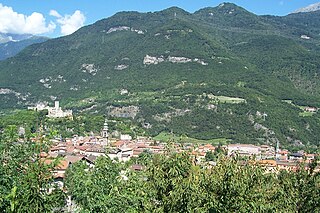
Breno[ˈbreːno] is an Italian comune of 4,986 inhabitants in Val Camonica, province of Brescia, in Lombardy.

Alatri is an Italian town and comune of the province of Frosinone in the region of Lazio, with c. 30,000 inhabitants. An ancient city of the Hernici, it is known for its megalithic acropolis.

Bettona is an ancient town and comune of Italy, in the province of Perugia in central Umbria at the northern edge of the Colli Martani range. It is 5 km (3 mi) E of Torgiano and 12 km (7 mi) SW of Assisi.
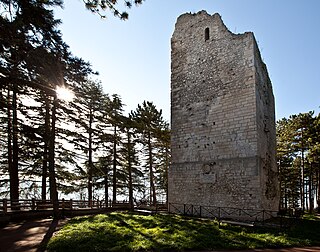
Guardiagrele is a town and comune in the province of Chieti, part of the Abruzzo region of central Italy. It is in the foothills of the Maiella mountain at an elevation of around 576 metres (1,890 ft). Its population numbers about 10,000.
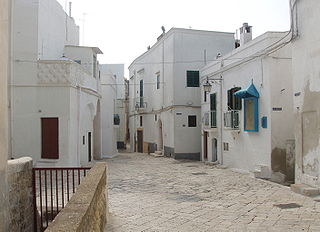
Castellaneta is a city and comune in the province of Taranto in the Apulia region of Southern Italy, about 40 km (25 mi) from Taranto. Located in a territory spanning from the Murgia to the Ionian Sea, characterized by numerous gravina (ravines), it is part of the Comunità Montana della Murgia Tarantina.
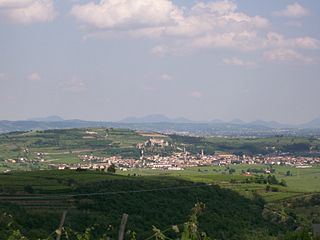
Soave is a small comune of the Veneto region in the Province of Verona, northern Italy, with a population of roughly 6,800 people.

San Fili is a town and comune in the province of Cosenza in the Calabria region of southern Italy.

Gazzo Veronese is a comune (municipality) in the Province of Verona in the Italian region Veneto, located about 100 km (62 mi) southwest of Venice and about 30 km (19 mi) south of Verona.

Pastrengo is a comune (municipality) in the Province of Verona in the Italian region Veneto, located about 120 kilometres (75 mi) west of Venice and about 15 kilometres (9 mi) northwest of Verona. As of 31 December 2004, it had a population of 2,486 and an area of 9.0 square kilometres (3.5 sq mi).

Pescantina is a comune (municipality) in the Province of Verona in the Italian region Veneto, located about 110 kilometres (68 mi) west of Venice and about 11 kilometres (7 mi) northwest of Verona. As of 31 December 2004, it had a population of 14,096 and an area of 19.7 square kilometres (7.6 sq mi).

Diano Castello is a comune (municipality) in the Province of Imperia in the Italian region Liguria, located about 90 kilometres (56 mi) southwest of Genoa and about 5 kilometres (3 mi) northeast of Imperia. As of 31 December 2004, it had a population of 2,061 and an area of 6.0 square kilometres (2.3 sq mi).

Montefalcone Appennino is a comune (municipality) in the Province of Fermo in the Italian region Marche, located about 85 kilometres (53 mi) south of Ancona, about 30 kilometres (19 mi) northwest of Ascoli Piceno and about 35 kilometres (22 mi) east of Fermo. It occupies a spur between the rivers Aso and Tenna.

Esperia is a comune (municipality) in the Province of Frosinone in the Italian region Lazio, located about 110 kilometres (68 mi) southeast of Rome and about 40 kilometres (25 mi) southeast of Frosinone. It is located within the Monti Aurunci Natural Park.

Valentino Rovisi was an Italian painter in a late Baroque style.
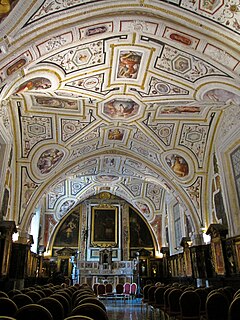
The Vasari Sacristy or Old Sacristy is a room in Sant'Anna dei Lombardi, Naples, Italy, one of its two sacristies. It was the refectory of the Olivetan monastery of Santa Maria di Monteoliveto until 1688, when it was converted to its current role. The conversion in 1688 revealed 15th century inlays by Fra Giovanni da Verona, also to be seen in the church's Tolosa Chapel. The church was renamed Sant'Anna dei Lombardi in 1805.
San Valentino is a Roman Catholic parish church, located near Piazzale Vittorio Veneto in the town of Bussolengo, province of Verona, region of Veneto, Italy.





















